Exercises (2269)
Passport stress
Forms of play / exercises
Partner work
The pair stand opposite each other (facing their partner). A distance of approx. 3-4 metres is maintained between the binomial. The binomial tries to string together 10 successful passes as quickly as possible. A pass is successful if the throwing disc (the frisbee), the ball (with the playing equipment) is caught or the shuttle (ball) is returned correctly. If a mistake is made (the disc or the ball/shuttle falls to the ground), the count starts again. The distance can be varied as desired after a successful attempt.
Variant I:
Multiple groups of 2 compete against each other (2 rows). The winning binomial is the one that is the first to string together 10 successful passes after the sports director's start signal. After each pass, the distance is increased (one row moves back 1-2 steps).
Variant II:
The sports leader specifies a throwing/striking/passing technique, provided that the individual techniques have already been practised.
Per participant:
1 racket/stick ► Intercrosse/Lacrosse, Smolball, Floorball, Badminton/Speedminton, Street Racket
Per group of 2:
1 throwing disc (Frisbee)/ball/shuttle ► Frisbee Ultimate, Basketball, Blitzball/Rugby/Football, FooBaSKILL, Futsal/Football, Handball, Intercrosse/Lacrosse, Smolball, Floorball, Volleyball, Badminton/Speedminton, Street Racket
Fits
Forms of play / exercises
Group work
4-6 participants per group
All participants move freely in the hall/area. Within the group, the participants pass a ball/throwing disc to each other. The sports leader can specify types of pass (e.g. ground pass, high pass, inside and outside instep, backhand, forehand, etc.) and throwing disc/ball receptions (e.g. one/two-handed catching, receiving with the sole of the foot, etc.). The exercise is then rearranged so that one group (e.g. blue) plays the ball/throwing disc to the other group (e.g. red) and in turn receives the ball/throwing disc from another group (e.g. green). The sports leader can integrate additional balls/throwing discs into the exercise.
Variant:
If the sports leader calls out the colour of a group with the addition "column" (e.g. "blue column"), the called group lines up in a row facing the back of the person in front (distance between the participants approx. 1-2 metres). Next, the sports leader calls a command for another group (e.g. command "red slalom"), which performs a movement task with the ball/throwing disc around the group lined up in column (e.g. bouncing the ball, guiding the ball with the feet or balancing the ball on a piece of equipment). The participant who has passed the slalom then passes the ball back to the next group member (e.g. past the lined-up group or between the spread legs). Once all group members have completed the slalom, all participants move freely around the hall/area again.
Per participant:
1 stick/stick ►intercrosse/lacrosse, smolball, floorball
1 wristband/stick ►team identification
Per group:
1 ball/throwing disc (Frisbee) ►Basketball, Frisbee Ultimate, FooBaSKILL, Futsal/Football, Handball, Intercrosse/Lacrosse, Smolball, Tchoukball, Floorball
Sports leader:
x additional balls/throwing discs (optional)
Passport collector
Forms of play / exercises
Group work
2 teams
Exercise description:
Two teams play against each other in a predetermined field. The aim is to play as many passes as possible within the team before an opponent can intercept the ball/throwing disc or the ball/throwing disc falls to the ground. If the pass attempt is intercepted or the ball/throwing disc falls to the ground, the right to pass the ball/disc changes hands and the other team now tries to collect as many successful passes as possible. Optional additional rule for more intensity: If a player in possession of the ball/disc is touched by a defender, he must immediately (within 2-3 seconds) play a pass, otherwise the right to attack also changes. Which team has achieved the most passes after a certain time?
Variant:
10 passes in a row result in one point, after which the right to the ball/disc changes.
1 ball/throwing disc ►Basketball, Blitzball/Touchrugby, Frisbee Ultimate, FooBaSKILL, Futsal/Football, Handball, Intercross/Lacrosse, Smolball, Tchoukball, Floorball
4 marking cones/caps (optional) ►Field markings
x playing ribbons/bibs ►Team identification
Pro Tn:
1 stick ►intercross/lacrosse, floorball
1 stick ►smolball
Passing game
Coordination exercises
Partner work
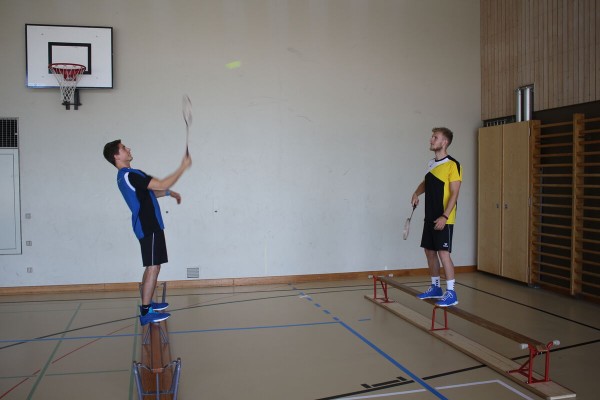
Two participants stand opposite each other on the thin side of a long bench at a distance of approx. 4-5 metres and play badminton (or Indiaca).
► Differentiation ability, orientation ability
Per group of 2:
2 badminton rackets
1 badminton shuttle
1 Indiaca
2 long benches
Post setup:
Place two long benches parallel to each other with a distance of approx. 4-5 metres and the narrow side facing upwards.
Passing game
Coordination exercises
Partner work
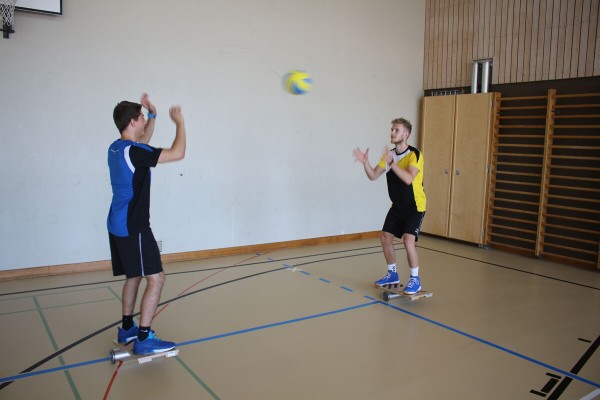
The participants stand approx. 3 metres apart and throw a volleyball at each other. Both participants stand on a medicine ball or a balance board and try to keep their balance. If the exercise is too difficult, the participants can support each other (hold/secure) and first try to stand reasonably safely on the medicine ball/balance board.
► Balance skills
2 balance boards/medicine balls
1 volleyball
Passing game
Coordination exercises
Partner work
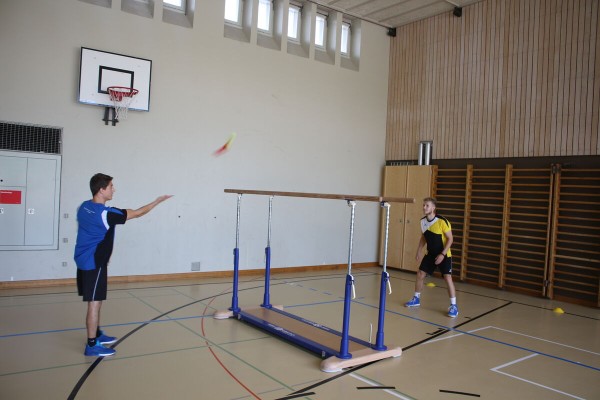
The participants pass an Indiaca to each other with the palms of their hands over the raised bar. They try to play right and left and keep the Indiaca in the air for as long as possible.
Variant:
Game (competition) for points.
► Differentiation ability, reaction ability
1 parallel bar
1 Indiaca
4 marking cones (optional) ►Playing field marking
Post set-up:
Fix the uprights of a parallel bar at a great height. Optionally mark a playing field around the bar using cones
Passing game
Coordination exercises
Partner work
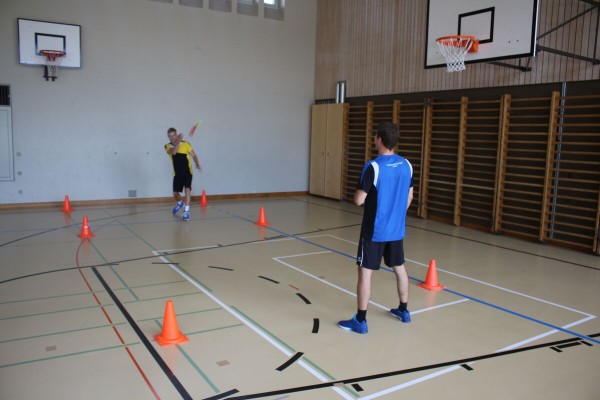
The participants stand opposite each other in two marked rectangles with a certain distance between the fields (approx. 4-5 metres for Indiaca/badminton; approx. 8-10 metres for speedminton). The participants play an Indiaca with the palms of their hands or a shuttle with their rackets. When playing with the Indiaca, participants try to play with the right and left. The aim is to keep the Indiaca/shuttle in the air for as long as possible.
Variant:
Game (competition) for points.
► Differentiation ability, reaction ability
8 marker cones/cups
1 Indiaca
Post set-up:
Mark out two playing fields using cones.
Passing game
Coordination exercises
Partner work
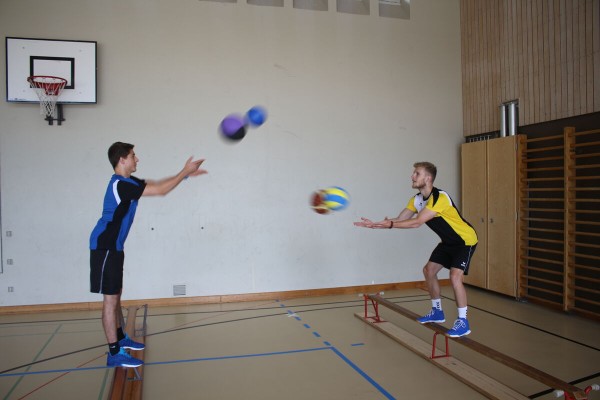
Two participants stand opposite each other on the narrow side of a long bench and pass two different balls to each other at the same time.
Variation:
Plays via the floor.
► Balance skills, differentiation skills
2 long benches
1 football
1 volleyball
1 softball
1 floorball
1 tennis ball
1 medicine ball
1 handball
1 lightning ball
Post setup:
Place two long benches parallel to each other with a distance of approx. 2-3 metres between them.
Passing game
Coordination exercises
Partner work
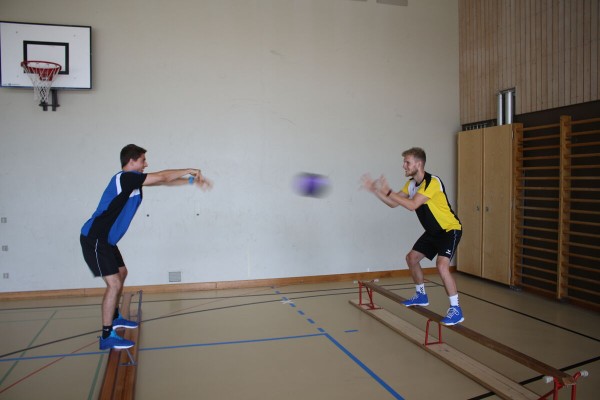
Two participants stand opposite each other on the narrow side of a long bench and try to unbalance their partner by throwing a medicine ball at them so that they have to leave the bench when they catch the ball.
► Balance skills
2 long benches
1 medicine ball
Post set-up:
Place two long benches parallel to each other at a distance of approx. 2-3 metres.
Break / postponement
Miscellaneous
Participants are given a break after each station. The recovery time is also used to move to the next station/post.
Pebble walk
Power
Individual work

Place 3 small stones on the floor; balance on two of these stones. Move the third free stone; switch to this stone with one foot. Repeat the process without losing your balance.
Lighten:
Without equipment;
Larger stones.
Harden:
With a backpack;
Smaller stones.
Material per participant: Tenue CNM
Additional material: 3 small stones
Pendulum run
Basic training
Partner work
A certain distance is to be covered several times in the same time. In the first run, the route is completed at as constant a pace as possible in accordance with the specified intensity range. The partner stops the time required for this and does not tell the runner. The roles are then swapped. At the start of the second run, the runners start with the aim of completing the course in exactly the same time. The partner stops the time again and calculates the difference to the first run.
Course: Circular run or out-and-back course (specify a maximum duration depending on the length of the course)
Intensity level: 3 (medium)
HFmax: 80-90%
Speech rule: speak in full sentences
Variant:
Complete the same course faster/slower by a certain time.
Per group of 2:
1 stopwatch
Chatting trot
Regeneration
Group work
Groups of two to four (adjust strength ratios)
The participants form groups of two to four and tell each other as much as possible about today / the past weekend / their plans for the future etc. during an endurance run. The intensity of the run is correspondingly low (nevertheless form strength groups). The endurance run takes place on a familiar circuit (if possible, do not choose the athletics track or the football pitch).
No material required.
Chatting trot
Basic training
Group work
4-6 participants per group (adjust strength ratios)
The participants form small groups and tell each other as much as possible about today/the past weekend/their plans for the future etc. during an endurance run. The intensity of the run is correspondingly low (nevertheless form strength groups). The endurance run takes place on a circular route (if possible, do not choose the athletics track or the football pitch) or a route that is run there and back.
Course: circuit; from A to B and back again
Intensity level: 1-2 (very easy-going)
Hmax: 60-80%
Speaking rule: sing-speak in full sentences
Attention:
The course must be known or clearly signalled to all participants.
Variant:
Swap partners/groups at half-time.
Signalling (e.g. route tape)
Evaluation FTA (group formation)
Participant:
1 heart rate monitor
Pop Vault
Parkour
Individual work

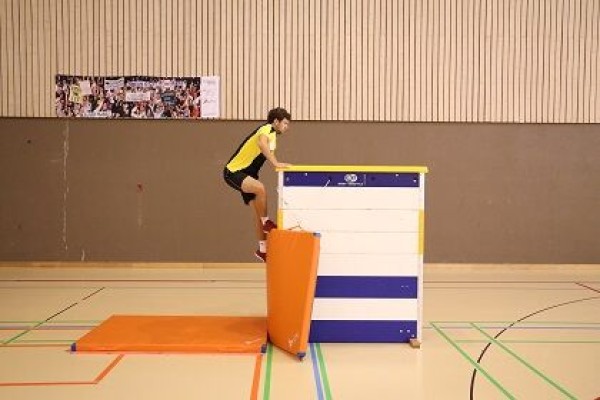

Frontal run-up to the front of the vaulting box, one-legged jump, push off upwards with the other leg on the mat, simultaneously pushing the body upwards with the hands on the top of the vaulting box to stand on the vaulting box.
2 vaulting boxes
2 soft mats (small)
2 skipping ropes
Post structure:
Stack the elements of two vaulting boxes on top of each other, attach a soft mat to the front using a skipping rope.
Hold position
Fighting and roughhousing games
Partner work
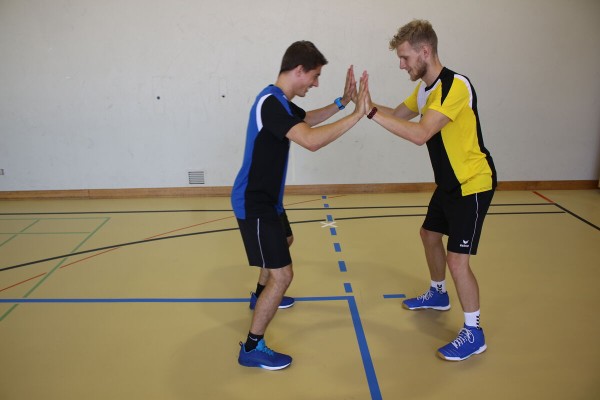
Two participants stand opposite each other in a slight straddle position and touch each other with their palms (or a small distance between the palms). The participants try to unbalance their opponent by pushing or dodging quickly and forcefully, without moving their feet. Whoever moves their feet loses.
No material required
Post run
Basic training
Group work
A continuous/loop run is carried out, in which strengthening exercises are integrated after a certain running distance (e.g. push-ups, trunk bends, pull-ups, jump forms, support legs, etc.). The strengthening exercises to be completed are specified either by means of posters or by a leader.
Course: circuit
Intensity level: 3 (medium)
Hmax: 80-90%
Rule of speech: speak in full sentences
Caution:
Course clearly visible from post to post (e.g. on sight, with signs).e.g. on sight, with signs or maps).
Variant:
Use existing course inside or outside the weapons range (defined course including permanently installed control posters).
x control posters (to be displayed in advance if not permanently installed)
1 exercise sequence (for sports leaders)
FTA evaluation (group formation)
Per participant:
1 heart rate monitor
Per group:
1 control overview
Powerrolle I
Parkour
Individual work
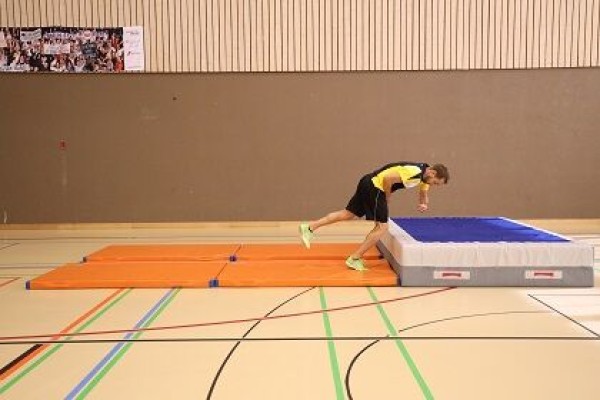


Lean forwards from a standing position, place your chin on your chest, rest one arm on a soft mat (on the grass ► outdoor variation), place your rolling arm on the back of your forearm, look under your outstretched arm, roll forwards over the shoulder of the bent arm directly to the standing position.
Variant:
Jump roll after a run-up onto a large soft mat, bringing your arms forwards in the air to cushion the impact and initiate the roll (►indoor variant).
1 soft mat (large) ► indoor version
2-3 soft mats (small) ► indoor version
Indoor post setup:
Lay out the soft mats in a row.
Powerrolle II
Parkour
Individual work
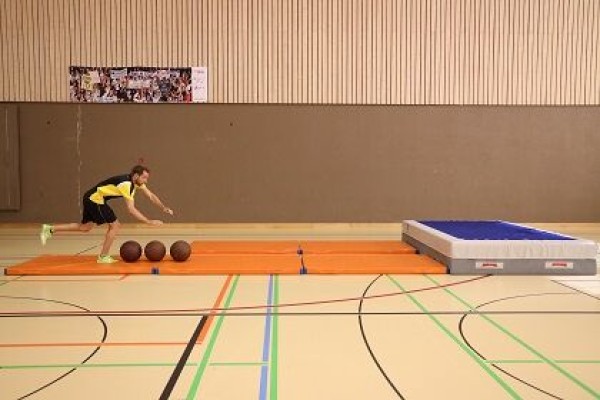
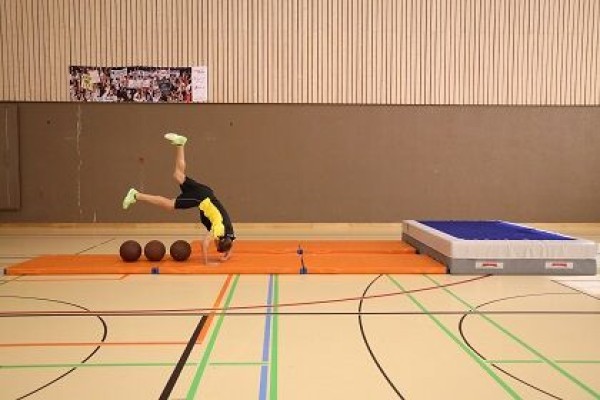
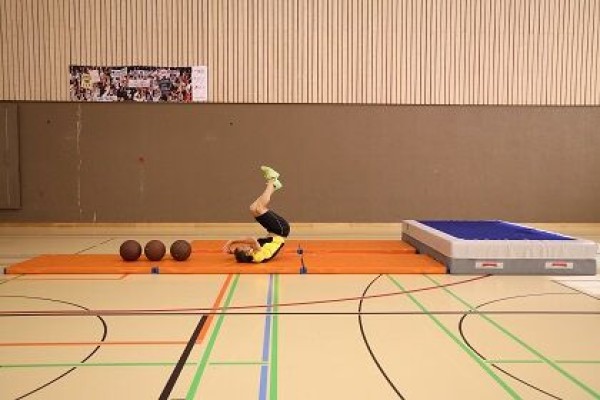
Jump roll over medicine balls, bringing the arms forwards in the air after the horizontal jump to cushion the impact and initiate the roll, place the roll arm on the back of the forearm, look under the outstretched arm, roll forwards over the shoulder of the bent arm directly to the standing position.
3 soft mats (small)
3 medicine balls
Post set-up:
Lay out the soft mats in a row and place the medicine balls on top (spacing depending on the desired jumping distance)
Powerrolle III
Parkour
Individual work
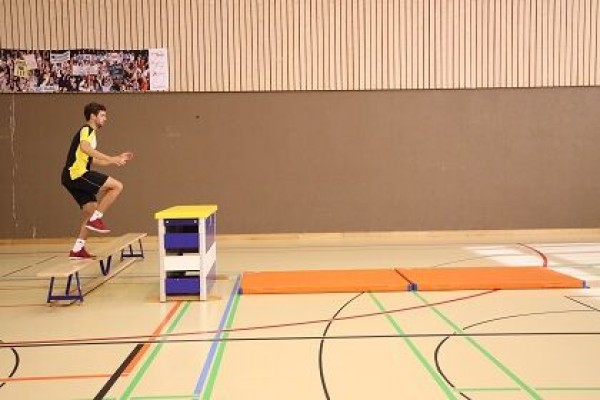
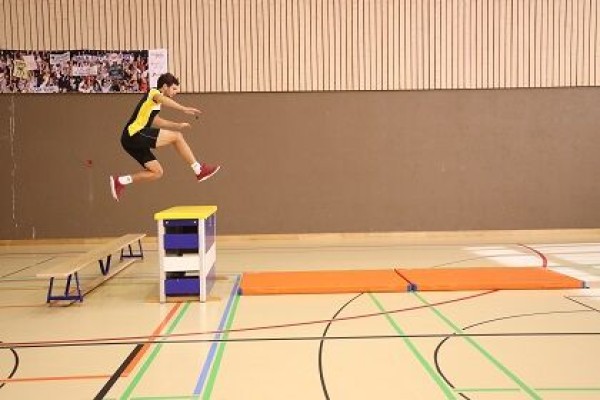
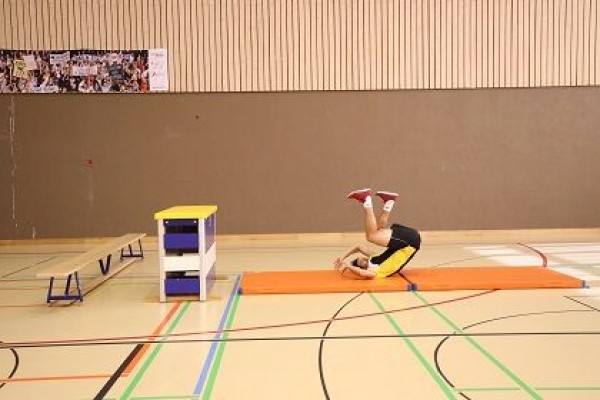
Short run-up, one-legged jump (on the long bench/swinging box top ► indoor version) over an obstacle (high jump facility/swinging box/horse ► indoor version), landing on the feet with an immediate roll (place the rolling arm on the back of the forearm, look under the outstretched arm, roll forwards over the shoulder of the bent arm directly to the standing position).
1 high jump facility (2 uprights with crossbar) or vaulting box/pommel horse ► indoor version
1 long bench ► indoor version
2 soft mats (small) ► indoor version
Post set-up indoor:
Place long bench approx. 1m in front of the high jump facility (parallel). 1m in front of the high jump area (parallel), lay out soft mats behind it.
outdoor:
grass area with obstacle (elevation or participant as obstacle replacement).
Precision jump I
Parkour
Individual work
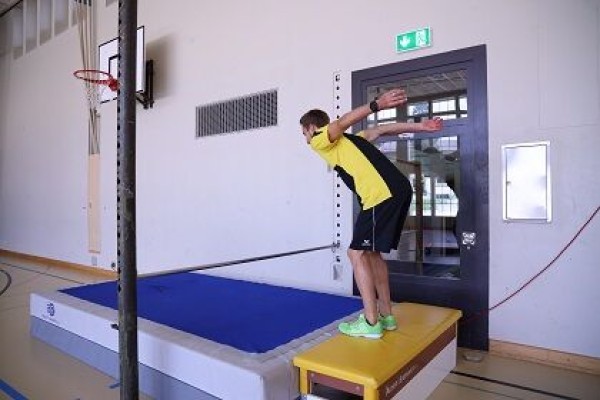
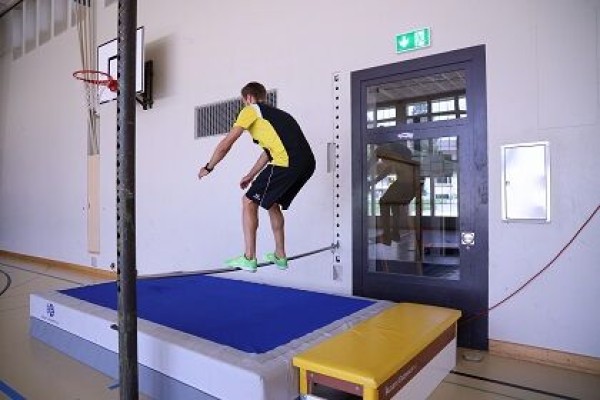
Jump from the top of the vaulting box onto the horizontal bar and then maintain your balance on it for as long as possible.
Variations:
Change the distance between the vaulting box and the horizontal bar;
Change the height of the horizontal bar and/or vaulting box;
Jump off after a running start;
Jump with a 180 or 360 degree turn.
outdoor:
Jump from one elevation to the other. Catch the jump in a controlled manner and keep your balance.
1 horizontal bar (pole) ►indoor version
1 soft mat (large) ►indoor version
1 vaulting box ►indoor version
Indoor post setup:
Fix the horizontal bar at a height of approx. 50 cm, set up a vaulting box (2 elements incl. top section) in front of it, place a soft mat underneath.
outdoor:
Two elevations (e.g. walls, steps, projections on houses, etc.) within jumping distance.
Precision jump II
Parkour
Individual work


Perform various jumps from the long benches to the top section of the vaulting box and vice versa.
Variant:
- Change the distances between the long benches and the top section of the vaulting box
- Additional vaulting box elements to change the height
- Jumps with 180 or 360 degree rotation
3 long benches
1 vaulting box (top section)
Post set-up:
Place the long benches in a triangle with the narrow side facing upwards, place a vaulting box top section in the centre.
Precision jump III
Parkour
Individual work


Jump from bench to bench, at the end hop onto or over the vaulting box onto the soft mat - the legs can be closed or open.
Variant:
- Change the distance between the benches
- Skip over the first bench and jump directly onto the second bench
- Integrate 180 or 360 degree turns when jumping from bench to bench
3 long benches
1 vaulting box
1 soft mat (large)
6 soft mats (small)
Post setup:
Place three upturned long benches and a vaulting box parallel to each other at a distance of approx. 50-150cm each, with small soft mats in between. There is a large soft mat behind the vaulting box.